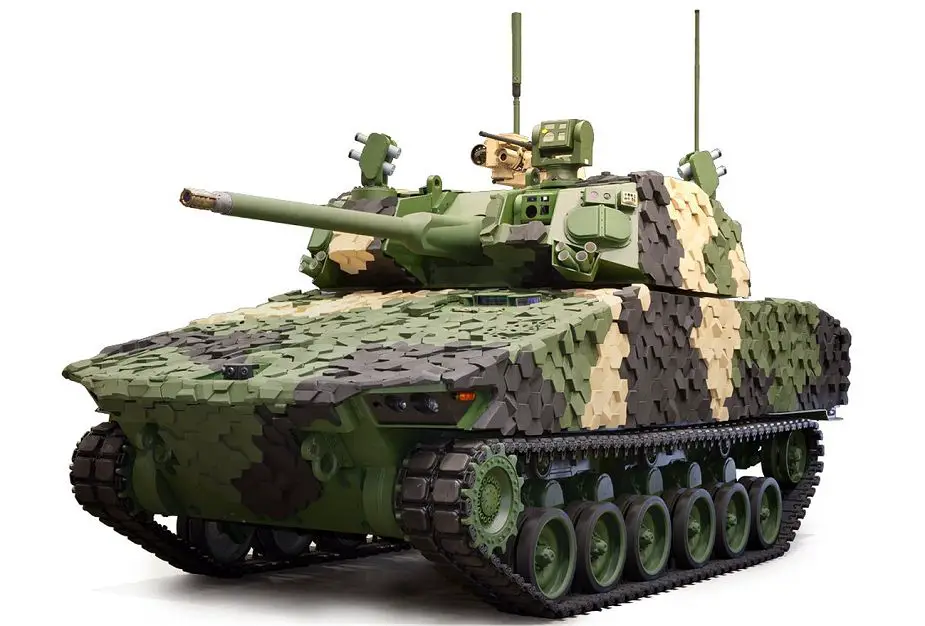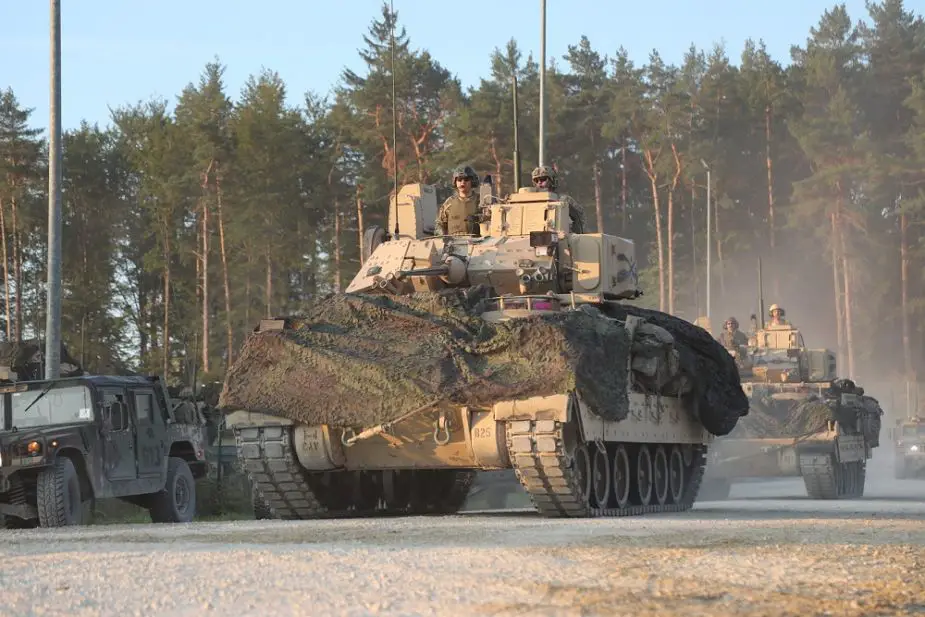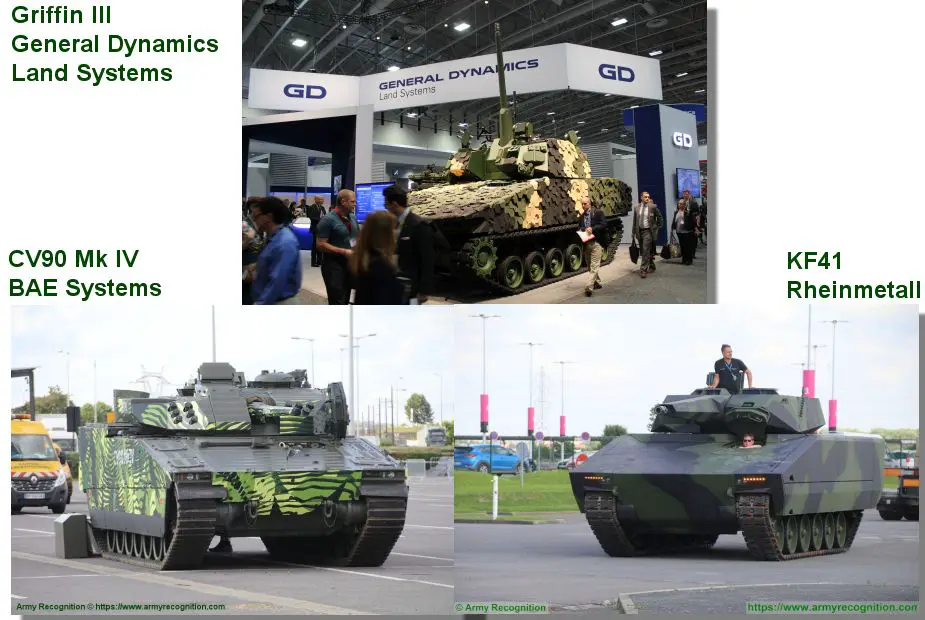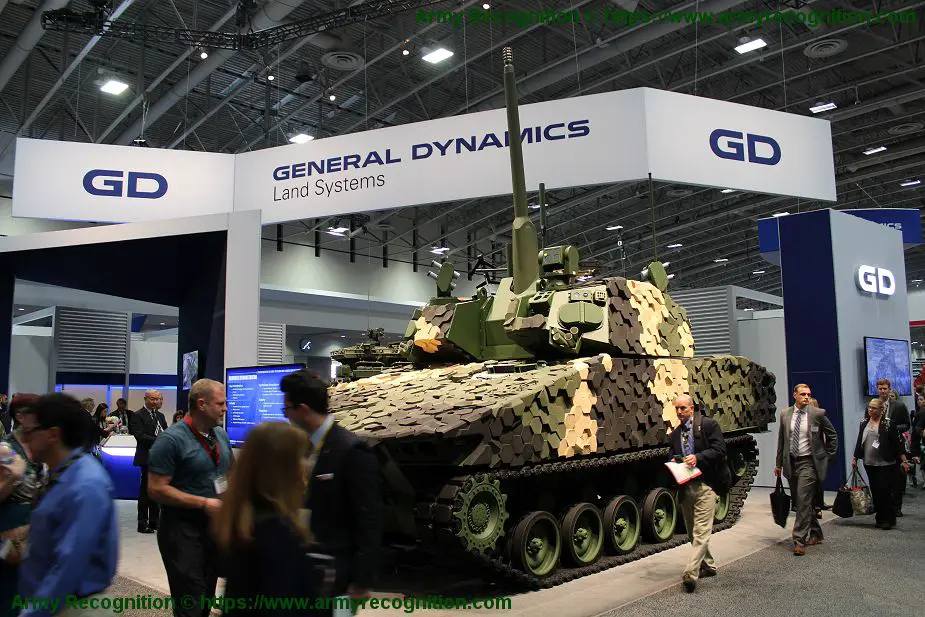Breaking news
General Dynamics Griffin III tracked armored candidate to replace Bradley IFV of US Army OMFV program.
Review and analysis of U.S. Army’s Optionally Manned Fighting Vehicle (OMFV) Program based on a document released by the U.S. Congressional Research Service on April 16, 2020. The General Dynamics Land Systems (GDLS) Griffin III technology demonstrator based on tracked armored vehicle chassis, one of the candidates for the OMFV program of the U.S. Army.

On April 22, 2020, General Dynamics showed its Griffin III demonstrator, a candidate for the Optionally Manned Fighting Vehicle (OMFV) Program of the U.S. Army. (Picture source Twitter account @nicholadrummond)
In June 2018, in part due to congressional concerns, the U.S. Army announced a new modernization strategy and designated the Next Generation Combat Vehicle (NGCV) as the program to replace the M-2 Bradley. In October 2018, Army leadership decided to redesignate the NGCV as the Optionally Manned Fighting Vehicle (OMFV) and to add additional vehicle programs to what would be called the NGCV Program.
On March 29, 2019, the U.S. Army issued a Request for Proposal (RFP)45 to industry for the OMFV. The Army has characterized its requirements as “aggressive” and noted industry might not be able to meet all requirements. Major requirements included the ability to transport two OMFVs in a C17 aircraft which will likely require the vehicle to have the ability to accommodate add-on armor; a threshold (minimum) requirement for a 30 mm cannon and a second generation forward looking infra-red radar (FLIR); and objective (desired) requirements for a 50 mm cannon and a third generation FLIR. By October 1, 2019, the industry was required to submit prototype vehicles to the Army for consideration and in the second quarter of FY2020 (Fiscal Year 2020), the Army planned to select two vendors to build 14 prototypes for further evaluation
On January 16, 2020, the U.S. Army canceled the current OMFV program, intending to restart the program following an analysis and revision of program requirements. According to Army officials, “a combination of requirements and schedule overwhelmed industry’s ability to respond within the Army’s timeline.”
On February 7, 2020, the US Army reopened the OMFV competition by releasing a new market survey with a minimally prescriptive wish list and an acquisition strategy that shifted most of the initial cost burden to the Army. On April 9, 2020, the Army provided new OMFV program guidance to industry featuring a five-phased approach to acquisition as well as a pledge to “reduce foreign barriers to competition,” and “identify a pathway to integrate relevant but immature technologies” into the program.
The U.S. Army requested $327.732 million in Research, Development, Test, and Evaluation (RDT&E) funding for the OMFV program in its FY2021 budget request.

U.S. Soldiers with 1st Squadron, 4th Cavalry Regiment, 1st Armored Brigade Combat Team, 1st Infantry Division, convoy in M2A3 Bradley Fighting Vehicles during Combined Resolve XII at the Hohenfels Training Area in Germany, Aug. 15, 2019. (Picture source U.S. DoD)
The M-2 Bradley, which has been in service since 1981, is an Infantry Fighting Vehicle (IFV) used to transport infantry on the battlefield and provide fire support to dismounted troops and suppress or destroy enemy fighting vehicles. Updated numerous times since its introduction, the M-2 Bradley is widely considered to have reached the technological limits of its capacity to accommodate new electronics, armor, and defense systems. Two past efforts to replace the M-2 Bradley—the Future Combat System (FCS) Program and the Ground Combat Vehicle (GCV) Program—were cancelled for programmatic and cost-associated reasons.
Despite numerous upgrades over its lifetime, the M-2 Bradley has what some consider a notable limitation. Although the M-2 Bradley can accommodate seven fully equipped infantry soldiers, infantry squads consist of nine soldiers. As a result, “each mechanized [ABCT] infantry platoon has to divide three squads between four Bradleys, meaning that all the members of a squad are not able to ride in the same vehicle.” 10 This limitation raises both command and control and employment challenges for Bradley-mounted infantry squads and platoons
Because the OMFV would be an important weapon system in the Army’s Armored Brigade Combat Teams (ABCTs), Congress may be concerned with how the OMFV would impact the effectiveness of ground forces over the full spectrum of military operations. Moreover, Congress might also be concerned with how much more capable the OMFV is projected to be over the M-2 Bradley to ensure that it is not just a costly marginal improvement over the current system. A number of past unsuccessful Army acquisition programs have served to heighten congressional oversight of Army programs, and the OMFV may be subject to a high degree of congressional interest.
 Three vendors showcased prospective platforms in the fall of 2018 including Griffin III from General Dynamics Land Systems, CV90 from BAE Systems and KF41 from Rheinmetall. (Picture source Army Recognition)
Three vendors showcased prospective platforms in the fall of 2018 including Griffin III from General Dynamics Land Systems, CV90 from BAE Systems and KF41 from Rheinmetall. (Picture source Army Recognition)
Reportedly, the U.S. Army originally planned to award a production contract for up to 3,590 OMFVs to a single vendor. Although the U.S. Army reportedly expected five to seven vendors to compete for the OMFV EMD contract, three vendors showcased prospective platforms in the fall of 2018.
BAE Systems had proposed its fifth-generation CV-90. The CV-90 was first fielded in Europe in the 1990s. The latest version mounted a 35 mm cannon provided by Northrop Grumman that can accommodate 50 mm munitions. The CV-90 featured the Israeli IMI Systems Iron Fist Active Protection System (APS). The CV-90 could accommodate a three-person crew and five infantry soldiers. On June 10, 2019, BAE reportedly announced it would not compete for the OMFV contract suggesting the requirements and acquisition schedule “did not align with our current focus or developmental; priorities.
Raytheon/Rheinmetall proposed its Lynx vehicle. It could mount a 50 mm cannon and thermal sights, and could accommodate both APS and UAVs. Raytheon states that the Lynx can accommodate a nine-soldier infantry squad. Reportedly, the U.S. Army disqualified the Raytheon/Rheinmetall bid because it failed to deliver a single OMFV prototype by October 1, 2019, as stipulated in the RFP, meaning only a single vendor—General Dynamics Land Systems (GDLS)—was left to compete for the EMD contract.
General Dynamics Land Systems (GDLS) proposed its Griffin III technology demonstrator, which used the British Ajax scout vehicle chassis. The Griffin III mounted a 50 mm cannon and could accommodate an APS and host unmanned aerial vehicles (UAVs). The Griffin II could accommodate a two-person crew and six infantry soldiers.

Griffin III tracked armored vehicle technology demonstrator from General Dynamics Land Systems at AUSA Defense Exhibition in Washington D.C. in October 2018. (Picture source Army Recognition)
In October 2018, during AUSA, defense exhibition in Washington D.C., GDLS has unveiled its new technology demonstrator, Griffin III. The General Dynamics Griffin III light tank concept that was presented at AUSA 2018 is based on the hull of the Ajax tracked armored vehicle, formerly known as the Scout SV, developed by General Dynamics UK to replace the family of CVRT tracked reconnaissance vehicles in the British Army.
The Griffin III is an armored vehicle in the category of a light tank fitted with a new turret armed with a 50mm automatic cannon including auto-loading system developed by the US Army’s Armament Research, Development and Engineering Center. The turret has a traverse of 360°, while the 50mm cannon has an elevation from +85° to -20°. The vehicle is able to carry a squad of 6 infantrymen.
To increase its self-protection, the Griffin III displayed at AUSA 2018, is fitted with an hexagonal camouflage called Tacticam from Armorworks designed to reduce vehicle signature in radar, infrared and visual spectrum. The turret is also equipped with the Iron Fist APS (Active Protection System) developed and designed by IMI Systems, formerly Israel Military Industries. This APS is s designed to increase the self-defense capabilities of the entire range of armored platforms against modern battlefield threats, such as anti-tank missiles and tank rounds, including Kinetic Energy (KE) projectiles. IMI’s IRON FIST sensor suite provides the vehicle and crew with a day/night 360º situational awareness, and its APS incorporates two layers of protection: Soft-Kill, using an electro-optic directional jammer, and Hard-Kill, based on interception of the threat at a safe distance from the defended platform.
With Griffin III, General Dynamics would like to introduce a new generation of light tank with a weight of less than 40 tons that can be easily and quickly deployed by military aircraft offering a high level of protection and firepower.
The Griffin III provides Soldiers a revolutionary leap in lethality and stand-off, a modular turret that accommodates several weapon system configurations, scalable protection for Multi-Domain Operations and an integrated Active Protection System (APS). Designed with an open architecture for rapid growth over time, the Griffin III also accommodates multiple crew and squad configurations.


























